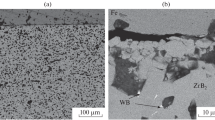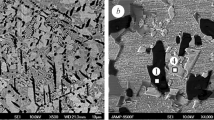The interaction of titanium diboride with iron and Kh18N10T iron alloy (equivalent to AISI 321H) in the temperature range 1200–1850°C was studied. No solid-state interaction was found at the contact interface. In the high-temperature range, the interaction proceeds according to the contact melting mechanism, which is characteristic of eutectic systems. Contact melting in the iron–titanium diboride system occurs at ~1400°C and in the 321H–diboride system at ~1340°C. The resultant liquid phase wets the diboride surface with a contact angle of ~40°. When temperature increases to 1450°C, the contact angle does not change and the droplet does not spread over the surface. Study of the alloys showed that the eutectic was found at point 9 ± 2 wt.% TiB2 for the Fe–TiB2 system and 6–7 wt.% TiB2 for the 321H–TiB2 system. The phase composition of the eutectic depends on the titanium diboride amount in the alloy. In the Fe–TiB2 system, the crystallized alloy retains the original phase composition (Fe, TiB2) but has a hypoeutectic, hypereutectic, or eutectic structure. At high TiB2 content, titanium diboride that did not participate in the interaction was identified in the alloy. In the 321H–TiB2 alloys, in addition to the main components (stainless steel and titanium diboride), small amounts of TiC and σ-phase (Cr0.56Fe0.46), resulting from stainless steel decomposition, were found. The experimental data indicate that iron in contact with titanium diboride can operate up to 1400°C and 321H iron alloy up to 1300°C. Iron and its alloys are promising matrix materials for composites in which pure iron or iron alloys are a metallic matrix and titanium diboride is a hard and wear-resistant component.
Access this article
We’re sorry, something doesn't seem to be working properly.
Please try refreshing the page. If that doesn't work, please contact support so we can address the problem.







Similar content being viewed by others
References
G.V. Samsonov and I.M. Vinnitskii, Refractory Compounds [in Russian], Metallurgiya, Moscow (1976), p. 558.
G.V. Samsonov, L.Ya. Markovskii, A.F. Zhigag, and V.A. Lyashko, Boron and Its Compounds and Alloys [in Russian], Izd. Akad. Nauk USSR, Kyiv (1960), p. 596.
G.V. Samsonov, T.I. Serebryakova, and V.A. Neronov, Borides [in Russian], Atomizdat, Moscow (1975), p. 374.
S.S. Kiparisov, G.A. Libenson, and A.P. Pankevich, “On sintering mechanism in the production of lowporous titanium boride parts,” Tsvet. Metall., No. 5, 145–149 (1974).
G.L. Zhunkovskii, P.V. Mazur, and T.M. Evtushok, Structure and Some Properties of Double Titanium–Chromium Boride Composites [in Russian], Inst. Probl. Materialoved. AN USSR, Kyiv (1990), pp. 130–136.
I.V. Fedorchenko and R.A. Andrievskii, Fundamentals of Powder Metallurgy [in Russian], Izd. Akad. Nauk USSR, Kyiv (1961), p. 420.
H. Zhang, H. Springer, R. Aparicio-Fernandez, and D. Raabe, “Improving the mechanical properties of Fe–TiB2 high modulus steels through controlled solidification processes,” Acta Mater., No. 118, 187–195 (2016).
L.V. Tarasenko and V.I. Titov, “Phase instability processes in heat-resistant steels in long-term heating,” Metalloved. Term. Obrab. Met., No. 12, 1–14 (2005).
Author information
Authors and Affiliations
Corresponding author
Additional information
Translated from Poroshkova Metallurgiya, Vol. 60, Nos. 7–8 (540), pp. 95–103, 2021.
Rights and permissions
About this article
Cite this article
Zhunkovskii, G., Grigoriev, O. & Vedel, D. Interaction of Titanium Diboride with Iron and AISI 321H Stainless Steel. Powder Metall Met Ceram 60, 464–471 (2021). https://doi.org/10.1007/s11106-021-00257-7
Received:
Published:
Issue Date:
DOI: https://doi.org/10.1007/s11106-021-00257-7




